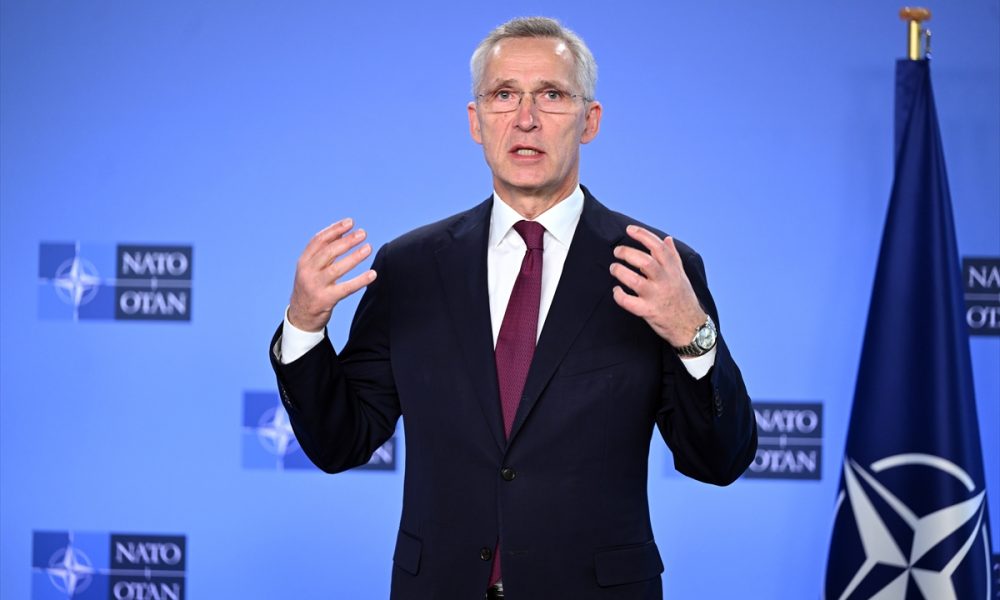Europe
Stoltenberg’s Ukraine plan fails to get full backing from NATO members

NATO Secretary General Jens Stoltenberg wants to “revolutionise” the way the alliance finances and arms Ukraine, but his plan for a $100 billion fund failed to get the response he wanted from NATO foreign ministers on Wednesday.
The secretary-general’s idea was to free military aid to Ukraine from political change and uncertainty by creating a five-year €100 billion fund and making the alliance shoulder more of the burden of arming Kiev.
“We need to provide Ukraine with reliable and predictable long-term security assistance. So we will rely less on voluntary contributions and more on NATO commitments. We should rely less on short-term offers and more on multi-year commitments,” he said.
The impetus for Stoltenberg’s plan is the situation in Washington, where a $60 billion military aid bill remains stalled in Congress due to opposition from some members of the Republican Party and presidential candidate Donald Trump.
NATO’s official role in Ukraine will change completely
Stoltenberg avoided mentioning Trump by name, but made it clear that the situation in Washington was worrying.
“Every day that the US delays its decision to provide more support to Ukraine will have consequences on the battlefield,” Stoltenberg said, adding that Russia now has more weapons than Ukraine.
According to POLITICO, the secretary general’s plan would “upend” NATO’s current role. Most of the alliance’s 32 members are providing military aid and cash to Ukraine through the US-led ‘Ramstein Group’, which organises arms shipments to Ukraine.
Taking over responsibility for this organisation would mean that the alliance would go beyond its current role, which focuses exclusively on “non-lethal assistance” to Ukraine.
“NATO taking a stronger role in coordinating and providing assistance is one way to end this war in a way that Ukraine emerges victorious,” Stoltenberg argued.
Aiming to decouple aid to Ukraine from US domestic politics
The aim is to make aid to Ukraine less dependent on national politics and to allow for long-term planning.
One proposal is for NATO members to contribute to the €100 billion fund according to the size of their economies. This would reduce the overall share paid by the United States and weaken Trump’s argument that European allies are not doing their part.
Stoltenberg dismissed concerns that a greater NATO role would weaken the American presence, stressing the dual role of US European Command and Supreme Allied Commander Europe Christopher Cavoli.
“General Cavoli is the US commander in Europe, but General Cavoli is also the NATO commander in Europe, and of course I think General Cavoli coordinates with General Cavoli; it’s the same person,” Stoltenberg said.
Support for NATO chief from Germany, Poland and Turkey
Such a radical change in Nato policy would require the approval of all members.
Although NATO spokeswoman Farah Dakhlallah said the ministers ‘agreed to plan for NATO to play a greater role in coordinating assistance to Ukraine’, discussions are expected to continue until the July summit in Washington.
Polish Foreign Minister Radoslaw Sikorski said he supported Stoltenberg’s efforts to help Ukraine, while a NATO official briefed on the matter said Turkey agreed.
German Foreign Minister Annalena Baerbock said it was important to create “reliable, long-term structures” to help Ukraine.
Some countries are sceptical about the plan
According to POLITICO, initial reactions from ministers in Brussels on Thursday to celebrate the alliance’s 75th anniversary were mixed.
After the presentation, some ministers “rolled their eyes” at the €100 billion figure and wondered where it came from, said a diplomat who requested anonymity.
“It is dangerous to make promises we cannot keep,” warned Belgian Foreign Minister Hadja Lahbib.
At the same time, some Western European countries are concerned that giving Nato so much money and power will undermine the European Union’s efforts to play a greater role in defence.
Where will the money come from?
The NATO proposal has also raised many questions about the details. A key issue is whether the financial target will come from the new fund or from existing programmes that individual allies send to Ukraine.
Diplomats pointed out that Stoltenberg had refused to disclose the amount in his proposal and warned that the discussion on funding was still at a very early stage.
“We welcome the initiative, but we need to see the practical applications and details,” said Czech Foreign Minister Jan Lipavský.
Spanish Foreign Minister José Manuel Albares stressed that Ukraine should calculate how much money it needs “to protect its democracy, sovereignty and territorial integrity”.
Hungary’s objection
Hungarian Foreign Minister Péter Szijjártó insisted that NATO is only a “defence alliance”.
“Hungary will reject any proposal to turn Nato into an offensive alliance, as this would lead to a serious risk of escalation,” Szijjártó said in a statement ahead of the meeting. This is not Hungary’s war, it is not NATO’s war,” he said.
But Stoltenberg argued that creating more certainty about how Ukraine would be armed and financed would “also send a clear message to the Kremlin”.
“We see that Russia is pushing and trying to win this war by waiting for us. So we have to respond by sending a clear message about practical support, financial support and an institutional framework that will allow us to be there in the long term to end the war,” the NATO chief said.